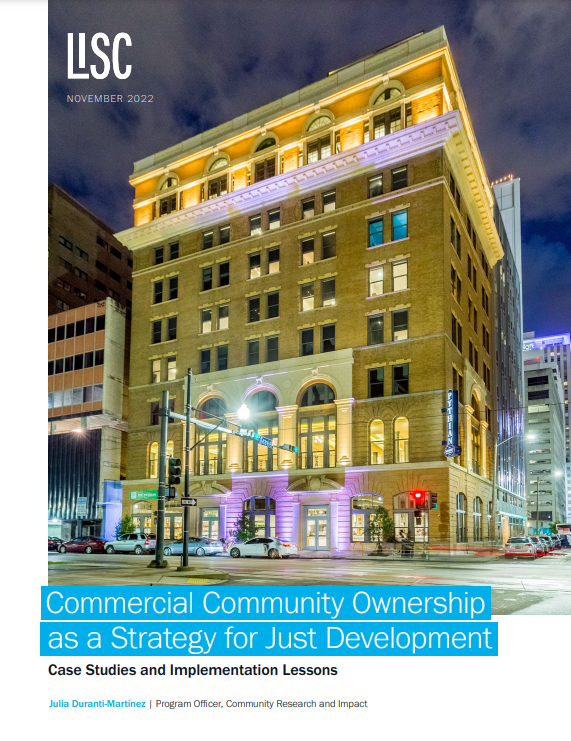Commercial Community Ownership as a Strategy for Just Development
In the wake of the pandemic and the ongoing struggle for racial justice, community ownership is gaining momentum as a critical strategy to build community power and promote just development without displacement. But less has been written about community ownership of commercial space, despite its potential to address many of the inequities that BIPOC-led small businesses and community-based organizations face. A new LISC report highlights commercial community ownership strategies and shares lessons and recommendations from groups working to preserve affordable space for small businesses and community organizations, build community wealth, and promote community-led economic development.
Executive Summary
In the wake of the pandemic and the ongoing struggle for racial justice, community ownership of land, housing, and other critical resources has drawn increased attention as a strategy to build community power and repair ongoing harms caused by centuries of racism and extractive development. Many excellent resources exist on these topics, and are increasingly highlighting powerful efforts led by Black, Indigenous, and people of color (BIPOC) communities that continue long traditions of cooperation, mutual aid, and community care. But comparatively little has been written about community ownership of commercial space, despite its potential to address many of the inequities that BIPOC-led small businesses and community-based organizations face.
This report adds to a growing area of interest by summarizing existing research and providing case studies of five established and emerging commercial community ownership projects working to preserve community-serving businesses, build community wealth, and promote community-led economic development from within. Achieving these broader goals depends not just on what model groups pursue, but also on how meaningful community capacity, leadership, and power are built over time, with attention to the ways that commercial development differs from affordable housing or mixed-used projects. Regardless of the specific form they take, community ownership models are not themselves the endpoint, but tools for repairing longstanding harms and promoting just development without displacement through reshaping relationships between people, place, power, and property.1
The five case studies featured in the report suggest some important lessons for community development and community ownership movements, in realizing these broader goals:
- In response to both disinvestment and speculation in commercial properties, the groups interviewed for this report largely moved quickly to raise capital and acquire and rehabilitate properties first, and then engaged in broader community planning, engagement, and organizing to shape uses for the space and the organization’s activities, including plans to eventually transition from nonprofit to direct tenant ownership. This sequencing (acquisition then community engagement) suggests that community development corporations (CDCs) and other groups interested in creating and preserving affordable commercial space can work with residents to move toward the goal of genuine community ownership. Groups emphasized the importance of defining goals and values at the outset to guide these processes and determine what model is most strategic.
- Because small businesses face challenges that can undermine the financial viability of a project, and because subsidies for affordable commercial real estate are generally limited, groups stressed the importance of conducting a commercial feasibility analysis and due diligence on properties, as well as building organizational capacity and leveraging strong partnerships with organizations that have experience in commercial development, property management, and asset management. These partnerships can also help overcome any shorter-term gaps in technical knowledge or experience on the part of developers who may have more experience in housing than commercial real estate, as long as the work remains connected with community organizing and advocacy efforts as well as political movements for racial, economic, and environmental justice.
- As part of their stewardship role, groups interviewed are pairing affordable commercial space with technical assistance, outreach and support, and coaching for entrepreneurs. Groups emphasized working with tenants who may be experiencing operational or financial challenges, and one commercial community land trust (CLT) that is pursuing an ownership model for BIPOC-owned small businesses includes a provision in its ground lease allowing the CLT to step in and cure defaults, similar to residential CLTs that work to prevent home foreclosures. These features differentiate community ownership models from conventional landlords, and justify their greater funding and support from government and philanthropy, as described in the recommendations.
